

Plaza de San Ildefonso (Madrid) Coordenadas: Con el objeto de reubicar en la plaza a buena parte de los vendedores ambulantes que se encontraban en las inmediaciones del bario, se instaló el mercado de San Ildefonso en el periodo que va desde 1835 hasta que en 1970 fue desmantelado, ocupó gran parte de la superficie de la plaza.
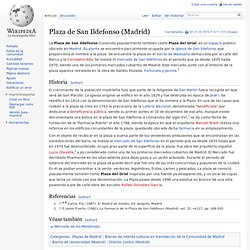
Fue obra del arquitecto español Lucio Olavieta,[1] y es considerado como uno de los primeros mercados cubiertos de Madrid. El Mercado fue derribado finalmente en los años setenta para dejar paso a un jardín arbolado. Durante el periodo de estancia del mercado en la plaza se puede decir que fue una de las más concurridas y populares de la ciudad. En él se podían encontrar a la venta: verduras, legumbres, frutas, carnes y pescados.
. ↑ Saltar a: a b Carlos Plá, (1987), El Madrid de Galdós, Ed. Retro shops in Malasana. Mercado de San Miguel. Museo Nacional Centro de Arte Reina Sofía. Museo Nacional del Prado. Buen Retiro park. Coordinates: Paseo de la Argentina Avenida de México Crystal Palace Rosaleda del Retiro Casita del Pescador Artificial mountain Statue.

Parque del buen retiro. Parque del Retiro, Madrid. The Parque del Buen Retiro is the most popular park in Madrid.
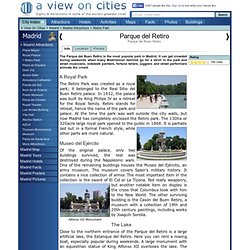
It can get crowded during weekends when many Madrilenian families go for a stroll in the park and street musicians, sidewalk painters, fortune tellers, jugglers and street performers animate the crowd. A Royal Park The Retiro Park was created as a royal park; it belonged to the Real Sitio del Buen Retiro palace. In 1632, the palace was built by King Philips IV as a retreat for the Royal family. Retiro stands for retreat, hence the name of the park and palace. Is partially laid out in a formal French style, while other parts are more natural. Museo del Ejército. Madrid Atocha railway station.
Madrid Atocha (Spanish: Estación de Madrid Atocha, also named Madrid Puerta de Atocha) is the largest railway station in Madrid.
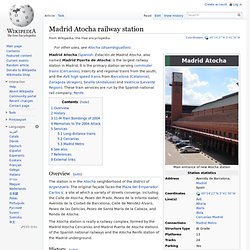
It is the primary station serving commuter trains (Cercanías), intercity and regional trains from the south, and the AVE high speed trains from Barcelona (Catalonia), Zaragoza (Aragon), Seville (Andalusia) and Valencia (Levante Region). These train services are run by the Spanish national rail company, Renfe. Overview[edit] The Atocha station is really a railway complex, formed by the Madrid Atocha Cercanías and Madrid Puerta de Atocha stations of the Spanish national railways and the Atocha Renfe station of the Madrid underground.
History[edit] Exterior of old Atocha station Interior plaza in old Atocha station At this site, Madrid's first railway station was inaugurated on 9 February 1851 under the name Estación de Mediodía (Atocha-Mediodía is now the name of an area of the Arganzuela district, and means south in old Spanish). 11-M Train Bombings of 2004[edit] Las Ventas. The Plaza de Toros de Las Ventas is a famous bullring in Madrid (Spain).
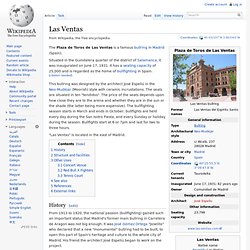
This bullring was designed by the architect José Espeliú in the Neo-Mudéjar (Moorish) style with ceramic incrustations. The seats are situated in ten "tendidos". The price of the seats depends upon how close they are to the arena and whether they are in the sun or the shade (the latter being more expensive). The bullfighting season starts in March and ends in October; bullfights are held every day during the San Isidro Fiesta, and every Sunday or holiday during the season. Bullfights start at 6 or 7pm and last for two to three hours. Plaza de Toros Las Ventas - Plaza de Toros de Madrid - Corridas de toros en Las Ventas. La Plaza de Toros de Las Ventas a été construit pour remplacer l'aréne situé sur la route de l'Aragon, par un autre plus grand, puisque la capacité de celui-ci était insuffisant en raison de la croissance de la population que Madrid a connu pendant la première moitié du XXe siècle.
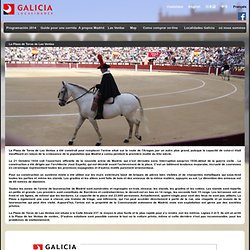
Le 21 Octobre 1934 voit l'ouverture officielle de la nouvelle arène de Madrid, qui s'est déroulée sans interruption jusqu'en 1936;début de la guerre civile . La construction a été dirigée par l'architecte José Espeliú, qui est décédé avant l'achèvement de la place. C'est un bâtiment tendance mozarabe, incrusté de couronnes en céramique représentant toutes les provinces espagnoles et d'autres motifs purement ornementaux.
Pour sa construction un système mixte a été utilisé sur les murs extérieurs basé de briques de pières bien visibles et de charpentes métalliques qui sous-tend toutes les parties et même les stands. Les gradins et les allées sont faits de bois et des anneaux de la même matière, appuyés au sol. Royal Palace of Madrid. The Palacio Real de Madrid (literally: Royal Palace of Madrid) is the official residence of the Spanish Royal Family at the city of Madrid, but is only used for state ceremonies.
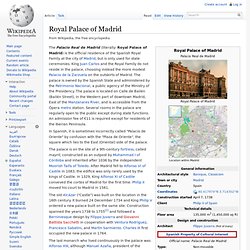
King Juan Carlos and the Royal Family do not reside in the palace, choosing instead the more modest Palacio de la Zarzuela on the outskirts of Madrid. The palace is owned by the Spanish State and administered by the Patrimonio Nacional, a public agency of the Ministry of the Presidency. The palace is located on Calle de Bailén (Bailén Street), in the Western part of downtown Madrid, East of the Manzanares River, and is accessible from the Ópera metro station. Several rooms in the palace are regularly open to the public except during state functions. An admission fee of €11 is required except for residents of the Iberian Peninsula. Toledo, Spain. Toledo is known as the "Imperial City" for having been the main venue of the court of Charles I, and as the "City of the Three Cultures", having been influenced by a historical co-existence of Christians, Muslims and Jews.
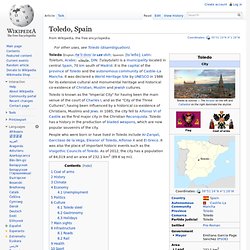
In 1085, the city fell to Alfonso VI of Castile as the first major city in the Christian Reconquista. Toledo has a history in the production of bladed weapons, which are now popular souvenirs of the city. Coat of arms[edit] The town was granted arms in the 16th Century, which by special royal privilege was based on the royal of arms of Spain. History[edit] Puerta del Sol.